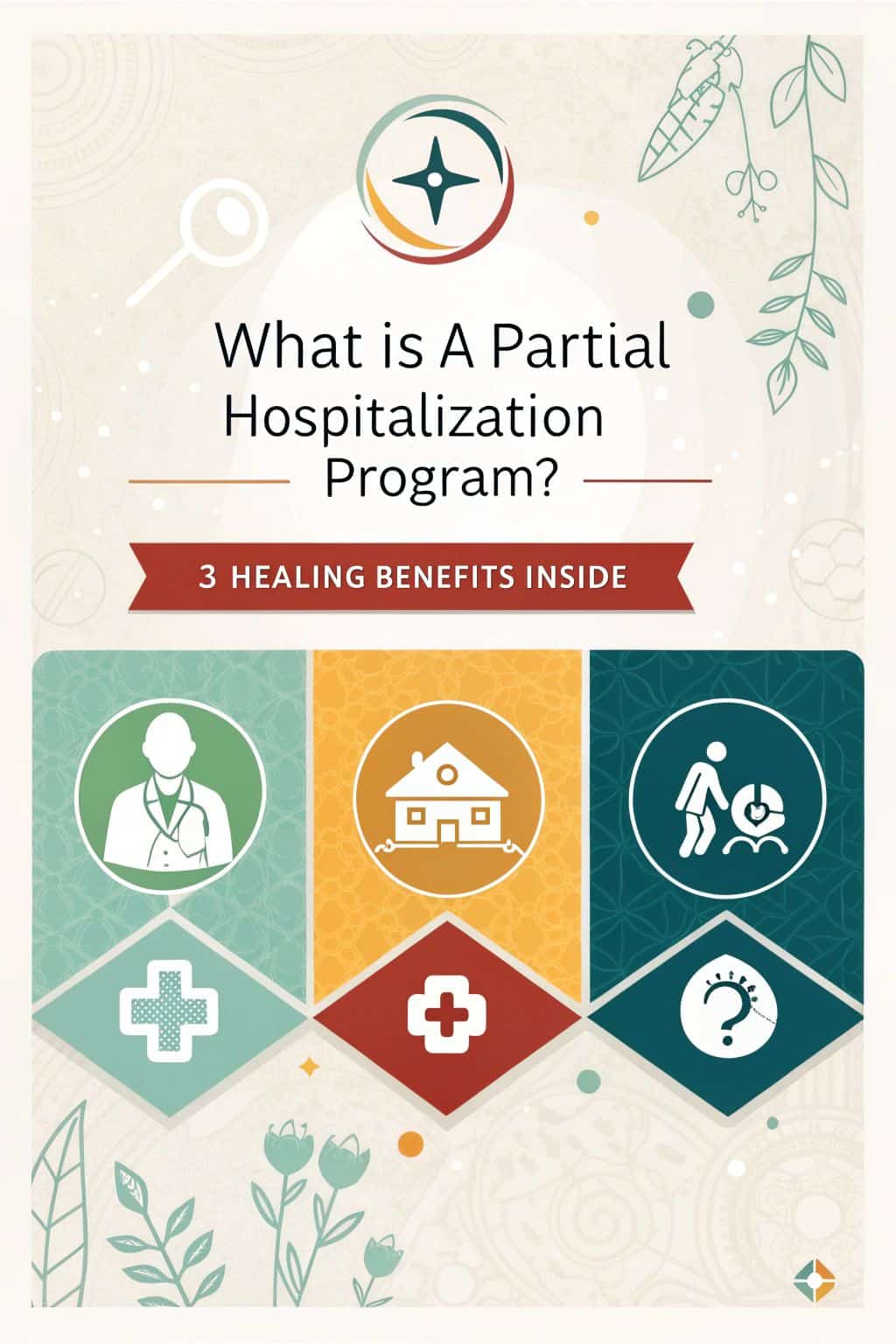Life with mental health struggles can feel like a heavy burden to carry alone. A Partial Hospitalization Program offers daily support and treatment while letting you sleep in your own bed at night.
If you’re asking “what is a partial hospitalization program,” it’s a middle ground between inpatient care and regular therapy sessions. We’ll show you three powerful benefits that make PHP a smart choice for healing.
Key Takeaways
PHP offers daily mental health care for 4–8 hours while letting patients sleep at home. The program runs up to five days weekly and includes therapy, medication help, and skill-building.
Studies show 92% of patients get better during PHP treatment, with only 5% needing to return within a month after finishing. Medicare Part B covers up to 80% of approved costs.
The program works well as a middle step between full hospital stays and regular therapy visits. Patients get help for conditions like anxiety, depression, PTSD, eating disorders, and substance use problems.
PHPs mix different types of care, including one-on-one counseling, group therapy, and daily living skills training. Most programs last several weeks to a few months, based on each person’s needs.
To join a PHP, patients need a stable home, reliable transportation, and the ability to attend daily sessions. They must be mentally stable and have support from a doctor or therapist.
Table of Contents
What is a Partial Hospitalization Program (PHP)?

A Partial Hospitalization Program offers structured mental health care during daytime hours. Patients attend treatment sessions for 4 to 8 hours daily, up to five days each week, and return home at night.
According to the Alvarado Parkway Institute (click to visit and learn more) this program bridges the gap between inpatient and outpatient care. The program combines group therapy, individual therapy, and medication management in a supportive setting.

PHPs serve as a vital step in mental health recovery. These programs last from several weeks to a few months based on each person’s needs. Patients get help for various conditions like anxiety disorders, major depression, or post-traumatic stress disorder (PTSD).
The treatment plan includes skill-building activities and therapeutic sessions. Many programs now offer telehealth options to make care more accessible. Mental health professionals create custom plans that focus on specific diagnoses, such as eating disorders or obsessive-compulsive disorder (OCD).
Key Objectives of a PHP

Building on the core structure of PHP programs, these treatment plans focus on clear goals for each patient. The main goals target symptom control through proven methods like cognitive behavioral therapy and medication management.
Mental health professionals work to teach vital coping skills that help patients handle daily stress. They guide patients through crisis prevention planning while supporting their path to recovery.
Each program creates a safe space for healing while letting patients return home daily. This mix of intensive care and home life makes PHPs perfect for steady progress. Patients learn distress tolerance through group therapy sessions and one-on-one counseling.
The treatment team helps build emotion regulation skills through dialectical behavior therapy. They also work on social connections and life skills that support long-term mental well-being.
Who Can Benefit From a PHP?

Partial hospitalization programs offer vital support for people facing tough mental health challenges. These programs help folks who need more care than weekly therapy but less than full hospital stays.
Mental health services through PHP work great for those dealing with substance use disorders, bipolar disorder, or PTSD. The program fits perfectly for people who struggle with daily tasks but still want to sleep in their own beds at night.
PHP became my lifeline when regular therapy wasn’t enough, but I wasn’t ready for inpatient care.
People transitioning from inpatient care often find PHP a perfect stepping stone to regular life. The structured environment helps manage psychiatric symptoms while building coping skills.
PHP proves ideal for those with dual diagnoses who need extra support through medication management and group therapy. Social workers and healthcare professionals create custom treatment plans that target specific mental health conditions.
Many insurance companies cover these programs, making them a practical choice for recovery.
Services and Treatment Options in a PHP

A PHP offers a mix of proven treatments to help you heal and grow. You’ll find support through one-on-one counseling, group sessions, and skill-building activities that fit your specific needs.
Therapy sessions

Therapy sessions form the backbone of partial hospitalization programs, offering both group and one-on-one support. Each day brings 4–6 hours of structured therapy time, mixing talk therapy with hands-on activities.
Your therapist will use proven methods like cognitive behavioral therapy and dialectical behavior therapy to help you build coping skills. Group sessions create a safe space to share experiences and learn from others facing similar challenges.
Individual therapy gives you private time to work through personal struggles with your counselor. These sessions happen 2–3 times per week for about an hour each. You’ll tackle specific issues like anxiety, depression, or substance abuse through various therapeutic approaches.
Many women find art therapy and motivational interviewing helpful parts of their treatment plan. The mix of different therapy types helps create a strong foundation for healing.
Medication management
 Medication management stands as a vital part of PHP care. Medical experts track how well your medicines work during each therapy session. Your treatment team watches for side effects and changes in your symptoms.
Medication management stands as a vital part of PHP care. Medical experts track how well your medicines work during each therapy session. Your treatment team watches for side effects and changes in your symptoms.
They make quick adjustments to your prescriptions based on your progress. The staff helps you stay on track with your medication schedule and teaches you about proper use.
A skilled medical team works together to create your perfect medication plan. Your doctor, nurses, and counselors meet often to discuss your progress. They look at how medications affect your mood, sleep, and daily life.
The team uses this info to make smart choices about your treatment. Many women find this hands-on support helpful in managing their mental health needs.
Skill-building activities
Skill-building activities in PHP programs focus on real-life tools you’ll use every day. I’ve seen patients learn stress management through art therapy, where they paint their feelings instead of bottling them up.
Music therapy helps many women express emotions they can’t put into words. These creative outlets work alongside practical skills like budget planning and healthy cooking. For those dealing with an alcoholic parent, these activities teach vital coping methods to handle tough family situations.
Daily living skills form the backbone of PHP treatment success. Group sessions teach social skills through role-play exercises. Patients practice assertive communication and boundary-setting in a safe space.
Time management workshops help organize daily routines. Some women learn job interview skills or resume writing. Others focus on self-care basics like sleep hygiene or exercise planning.
Each activity builds confidence for life after treatment. The program mixes cognitive behavior therapy with hands-on practice to make new habits stick.
Conditions Treated in a PHP

Partial hospitalization programs treat several serious mental health conditions that need structured care. Mental health professionals help patients with major depression, anxiety disorders, and bipolar disorder through daily therapy sessions.
People with OCD, PTSD, and eating disorders also find relief through PHP treatment plans. The programs offer special support for those dealing with substance use problems or having thoughts of suicide.
Recovery is not a straight path – it’s about progress, not perfection.
These programs mix different types of therapy to match each person’s needs. Cognitive-behavioral therapy helps change negative thought patterns. Group sessions let patients share experiences and learn from others facing similar struggles.
Medication management keeps symptoms under control while patients work on building better coping skills. Many patients start feeling better after a few weeks of consistent PHP care.
The structured daily schedule gives people the right amount of support without staying overnight in a hospital.
How Does a PHP Differ From Other Treatment Programs?

A PHP stands out from other mental health programs by offering more support than standard outpatient care, but less restriction than full hospital stays – perfect for those who need daily treatment while staying connected to their home life.
Ready to learn the exact differences between PHP and other care options?
PHP vs. Inpatient Programs
Understanding the differences between Partial Hospitalization Programs (PHP) and inpatient care helps you make informed choices for your mental health needs.
| Aspect | Partial Hospitalization Program | Inpatient Program |
|---|---|---|
| Living Arrangements | Return home each evening | Stay at facility 24/7 |
| Program Duration | 20–30 hours per week, 5 days | Round-the-clock care |
| Treatment Intensity | Structured daytime therapy | Constant supervision |
| Personal Freedom | More independence | Limited independence |
| Cost | Lower than inpatient care | Higher expenses |
| Family Contact | Daily family interaction | Limited visiting hours |
| Real-world Practice | Daily practice of skills | Controlled environment |
| Crisis Management | Moderate crisis support | Immediate crisis response |
| Medical Support | Regular monitoring | 24/7 medical care |
PHP vs. Intensive Outpatient Programs (IOPs)
Both PHPs and IOPs offer structured mental health care, but they differ in several key aspects. These programs serve as stepping stones in your recovery path, each with its own intensity and approach.
| Aspect | Partial Hospitalization Program (PHP) | Intensive Outpatient Program (IOP) |
|---|---|---|
| Time Commitment | 4–8 hours daily, 5 days/week | 3–4 hours daily, 3-5 days/week |
| Level of Care | Higher intensity treatment | Moderate intensity treatment |
| Living Situation | Return home each night | Live at home full-time |
| Medical Support | Regular medical monitoring | Less frequent medical oversight |
| Treatment Focus | Complex mental health conditions | Transition to daily life |
| Program Structure | Highly structured daily schedule | Flexible scheduling options |
| Crisis Management | Immediate access to crisis care | Limited crisis support |
| Therapy Types | Multiple daily therapy sessions | Group and individual therapy |
| Skill Building | Intensive daily practice | Weekly skill development |
Ladies, I’ve been through both programs myself. PHPs gave me the structure I needed during tough times. IOPs helped me ease back into my regular routine. Your choice might depend on your specific needs and daily responsibilities. Some women find PHPs perfect for intensive healing, while others thrive in the flexibility of IOPs.
Advantages of a PHP

Partial hospitalization programs pack powerful benefits for mental health recovery. These programs let you sleep in your own bed each night while getting top-level care during the day.
Studies show 92% of patients see their symptoms improve during PHP treatment. The programs cost less than staying in a hospital full-time, making them easier on your wallet. You’ll get support from therapists, doctors, and others who understand what you’re going through.
Recovery happens one day at a time, and PHP gives you the perfect balance of intensive care and home comfort.
Mental health services in PHPs offer a complete package under one roof. You’ll find individual therapy, group sessions, and medication management all in one place. The structured environment helps build daily routines while teaching vital coping skills.
Most patients do so well that only 5% need to return within a month after finishing the program. Medicare, Medicaid, and many insurance plans cover these services, making healing more accessible.
The flexible schedule works great for moms, working women, and anyone needing strong support while maintaining some independence.
Requirements for Admission to a PHP

Now that you know the advantages of PHP programs, let’s talk about what you need to get started. Getting into a PHP takes some basic requirements to make sure you’ll get the most from your treatment.
- You must have a stable place to live during treatment. This means having a safe home environment that supports your recovery goals.
- Daily attendance is a must. You’ll need to show up on time for all scheduled sessions, just like a regular job or school day.
- Your mental state needs to be stable enough for outpatient care. This means no active thoughts of suicide or plans to harm yourself or others.
- A support system matters. You’ll need a doctor, therapist, or primary care provider who backs your choice to join the program.
- Time commitment is key. Most programs need you to take a break from work or school to focus on healing.
- You should be able to handle basic tasks on your own. This includes getting dressed, eating meals, and taking prescribed medications without supervision.
- Insurance coverage or payment plans must be in place. Many health insurance companies cover PHP treatment, but you’ll want to check your specific plan.
- You need to pass an initial screening. A mental health expert will check if PHP matches your needs through an assessment.
- Transportation plans must be solid. You’ll need a reliable way to get to and from the program each day.
- Medical clearance is required. Your doctor must confirm you’re healthy enough for the program’s activities.
Cost and Insurance Coverage for PHPs

Most health insurance plans cover PHP services, with Medicare Part B paying up to 80% of approved costs. Your out-of-pocket expenses will depend on your specific plan’s deductible and whether you choose an in-network or out-of-network provider.
Medicare and Medicaid considerations
Medicare offers solid coverage for partial hospitalization programs through Part B benefits. Your doctor must write a letter stating why you need this care, and they’ll need to confirm this every 30 days.
The program pays for many helpful services like personal therapy, group sessions, and family counseling. You’ll start with a complete mental health check-up, and your doctor will create a care plan just for you.
Medicaid rules vary by state, but many plans cover PHP services for people who meet specific income limits. Both Medicare and Medicaid can work together if you qualify for both programs.
Your insurance might ask for a small copay, but these programs aim to keep costs low. Before starting treatment, a quick call to your insurance provider can clear up any payment questions.
The Affordable Care Act has made mental health coverage more available through these programs.
Effectiveness of Partial Hospitalization Programs

Research shows that partial hospitalization programs deliver strong results for mental health recovery. Studies reveal that 95% of patients who finish these programs would tell others to try them too.
Virtual programs match the success rates of in-person treatment across key areas like stress control and coping methods. Many patients see major improvements in their daily lives while staying connected to family and friends.
PHPs offer real hope through proven treatments like cognitive-behavioral therapy and dialectical behavior therapy. The programs help people build better social skills and handle life’s challenges.
Patients learn to manage their symptoms while keeping their normal routines at home. The mix of therapy types, medication support, and skill practice creates lasting positive change.
Most insurance plans, including Medicare Part B, cover these effective treatment options.
People Also Ask
What exactly is a Partial Hospitalization Program (PHP)?
A PHP is a structured day treatment program that helps people with mental health issues or drug and alcohol misuse. It offers therapy and support without overnight stays. You get help through individual therapy, group therapy, and medication management.
How is PHP different from other treatment options?
PHP sits between outpatient treatment and residential treatment programs. It’s more intensive than regular therapy, but less restrictive than hospital stays. You attend treatment during the day and go home at night, making it perfect for those who need extra support.
What treatments do PHPs typically offer?
PHPs provide many types of help, including cognitive-behavioral therapy (CBT), dialectical behavior therapy (DBT), and acceptance and commitment therapy (ACT). They also offer medication support with drugs like Zoloft, Celexa, or Effexor when needed.
Does insurance cover PHP treatment?
Most health insurance companies, Medicare Part B, and Medi-Cal cover PHP services. The pricing varies, but many insurance plans see it as a health benefit. It’s smart to check your coverage before starting.
Who can benefit from a PHP?
People dealing with PTSD, borderline personality, anxiety, or thoughts of suicide often find help in PHPs. It’s also good for those with co-occurring disorders or alcohol addiction who need psychosocial support.
What happens after completing a PHP?
Your team will create a discharge plan to help prevent relapse. This might include working with an addictions counselor, joining support groups, or moving to an intensive outpatient program (IOP). The goal is keeping you healthy long-term.
References
https://www.goodrx.com/health-topic/mental-health/partial-hospitalization-program
https://corerecoveryaz.com/what-are-the-goals-of-a-partial-hospitalization-program-php/
https://beaumontbh.com/blog/understanding-partial-hospitalization-programs-phps/ (2024-05-14)
https://gosnold.org/blog/the-benefits-of-a-partial-hospitalization-program/
https://www.newdayrecoveryservices.com/blog/benefits-php-outpatient (2024-12-19)
https://www.risingphoenixaz.com/blog/partial-hospitalization-program-guide/ (2023-09-22)
https://beaumontbh.com/blog/the-benefits-of-partial-hospitalization-programs/ (2024-05-14)
https://www.northstarbehavioralhealthmn.com/resources/what-is-partial-hospitalization-treatment (2024-03-21)
https://www.therecoveryvillage.com/treatment-program/partial-hospital/ (2024-09-18)
https://thebridgeway.com/blog/php-vs-iop-whats-the-difference/
https://www.renaissancerecovery.com/php-vs-iop/ (2024-08-29)
https://www.sunrisetreatmentcenter.net/requirements-for-partial-hospitalization-program
https://public.providerexpress.com/content/dam/ope-provexpr/us/pdfs/clinResourcesMain/guidelines/mcs/phpMCS.pdf (2024-07-16)
https://www.cms.gov/medicare-coverage-database/view/lcd.aspx?LCDId=37633
